Learn how to make a flour gravy that’s delicious and has the correct thickness every single time. The ratio of flour to fat to stock is given as well as the method for how to combine everything to make it taste amazing.
Making gravy used to be a mystery to me. I’d add flour to my roast’s drippings and maybe some broth or stock. Then season it up, stir it up, and simmer it up. Sometimes it would be delicious, thick but not too thick, meaty but not overpowering. Other times, it would taste a bit like flour, water, and salt. Too thin. Just plain not good.
I did some research and started making notes about what I was doing. I’m going to tell you the stuff that worked and what led to me being able to make perfect gravy every single time.
Want To Save This Recipe?
Enter your email address & I’ll send this recipe straight to your inbox to save for later! Plus, you’ll get new recipe ideas from me every week!
Gravy isn’t complicated but if you want to be great at it you need to understand why you’re doing each step. What I’ve done is to put a very lengthy explanation here with pictures and all the info you need. It has the method and also the gravy ratio for how much fat to use with how much flour and how much stock or broth.
This post is going to tell you how to make a gravy using flour. All-purpose white flour. You would use a different method if using cornstarch or any other flour as a thickener. If you want to use cornstarch, amounts are given over here in my Instant Pot Gravy recipe and also in this delicious Cornstarch Gravy Recipe.
As I said, the instructions are a bit lengthy but, at the bottom of this article, there’s a much shorter set of instructions in printable form that you can take into the kitchen with you.
If you have any questions, please put them in the comments below. I’m happy to answer and help you make the best gravy of your life, and I hope you’ll then keep making it for the rest of your life. It’s easy once you’ve got it down. Promise.
Video: Steps For Perfect Gravy
Ingredients
There’s only a few ingredients you need to create a delicious gravy from scratch. First, you’ll need butter or fat that has been rendered from your roast. You also want plenty of drippings from roasting your meat with the fat removed. Not making a roast or don’t have enough drippings? Not a problem, see my Gravy without Drippings recipe or keep reading to discover my other solutions.
Other than that, all you need is some all-purpose flour along with salt, pepper, and any other seasonings you want. Let’s get started on my best gravy recipe.
How To Make Gravy Perfectly Every Time
Step #1: Make Good Drippings
Drippings are the liquid (fat and juices) that pool at the bottom of your roasting pan when you cook a large piece of meat or poultry. The thing is, sometimes you don’t get a lot (or any) drippings. So I’ve found a way to get nice concentrated meat juices no matter what.
(Side Note: It is totally possible to make gravy without drippings if you, for instance, are a vegetarian or aren’t making a roast but want gravy anyhow. The method is a bit different but the results are great. Learn how to make gravy without drippings here).
To make sure that I have lots of good drippings, even from a small roast, I put unsalted store-bought broth in the bottom of the roasting pan while the roast cooks. Just a quarter of an inch or so.
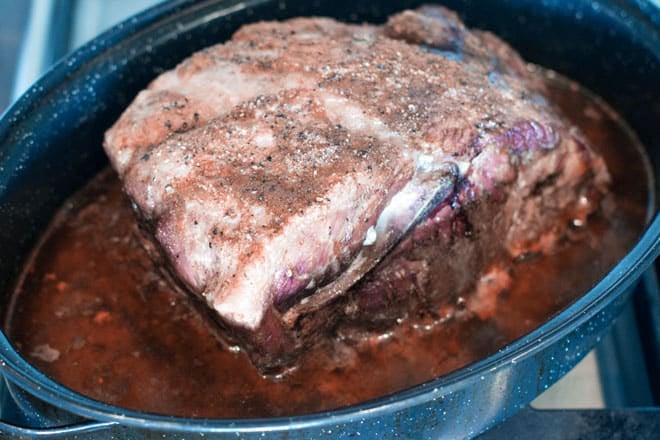
To get amazing drippings when roasting a turkey, head to this recipe. I cannot say enough good things about how amazing the gravy from this turkey end up!
Why do you need good drippings?
I first explained how and why to do this when I did the instructions for How to Roast Pork Perfectly over here. But basically, that broth evaporates as the roast cooks. As it does, some of the broth is left on the sides and bottoms of the pan. Those bits caramelize there. Midway through roasting, add more liquid and it will wash those caramelized bits into your juices making them more delicious.
Also, by putting broth in the bottom of the pan I counteract something that can happen with roasts. Sometimes you get nice juices coming off of the roast. Other times, not as much. When there’s less they can sometimes burn a bit on the bottom of the pan. A mild caramelization of juices is fantastic. But too much and your drippings will taste burnt and then so will your gravy.
Having the broth in the bottom of the pan stops the possibility of burning. Instead, juices that fall from the roast drop into the broth and mix in there.
Step #2: Separate The Juices
Pour all the juices from the roasting pan into a gravy separator.
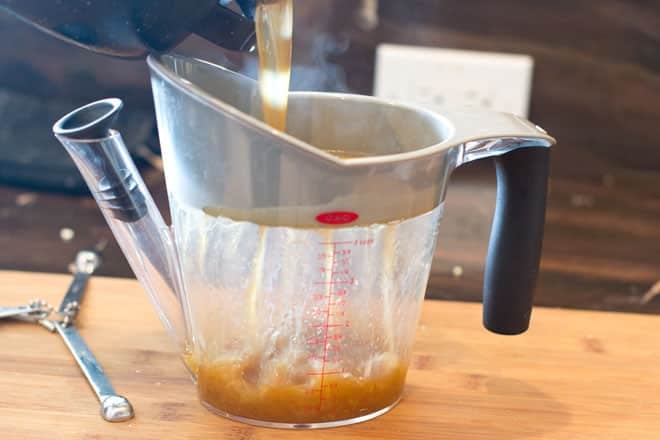
This is like a measuring cup with a long spout that goes right to the bottom of the cup. The fat of your drippings will rise to the top and the tasty juices will stay at the bottom.
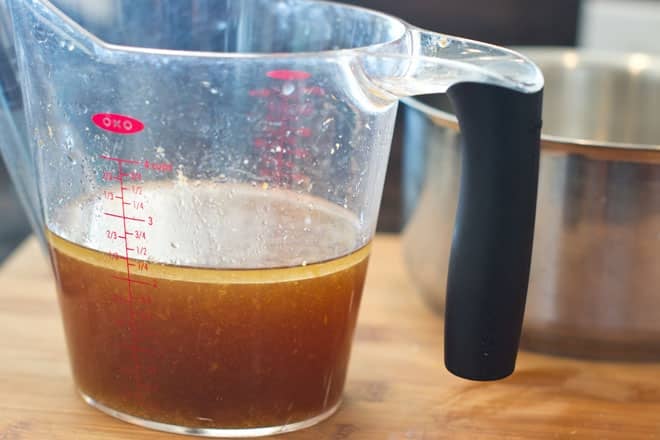
When you pour from a gravy separator, the spout is down at the bottom so it gets your juices out first, not your fat. (Although we are going to use some of that fat. Don’t you worry!)
Step #3: Get All The Flavor From The Pan
You need to get all of the flavor out of the roasting pan.
I use a spatula to make sure I’m getting all the browned bits and then anything else from the bottom of the pan.
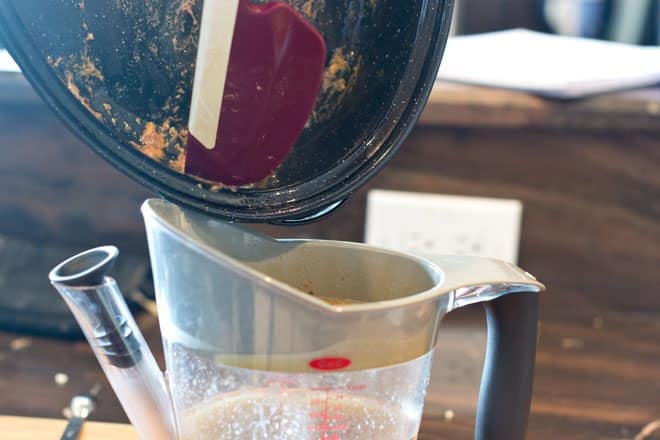
Why I don’t make gravy in a roasting pan:
Unlike a lot of people, I don’t make my gravy right in the roasting pan. I find that it’s too big and is harder to incorporate the ingredients.
Instead, just use that spatula like I said and make sure you get all the goodness out. After using the spatula, if there’s a lot of nice caramelization on the roasting pan, pour some wine or water (1/2 cup should do) in there and bring it to a simmer, stirring around and then add that to the juices in your gravy separator.
Step #4: Ratio Of Fat, Flour, And Liquid For A Perfect Roux Gravy
I should say that there are several different methods to make gravy. My favorite gravy is a flour roux gravy because I feel like I really have control of the amount I make and the eventual thickness. So that’s what I’m explaining here.
Tip: The important thing to know when making a roux gravy is the ratio of flour to fat to liquid. The ratio I use is:
1.5 tablespoons fat to 1.5 tablespoons flour to 1 cup liquid, which yields 1 cup of gravy.
(Note: If you like your gravy thicker, go with 2 tablespoons of fat and 2 tablespoons of flour to 1 cup of liquid, which yields 1 cup of gravy).
What you do is decide how many servings of gravy you need and then work from that towards the above ratio to get your amounts.
Let’s figure out the amounts we need:
You’ll want 1/3 – 1/2 of a cup of gravy per person. So if you need 6 servings then you want 2-3 cups. I tend to go with the higher amount because I like leftover gravy. (For ideas of what to do with leftover gravy, check this out!). But probably most people can go with the smaller amount.
For 6 people we need 3 cups of gravy so we’ll need:
- 4.5 tablespoons of fat (that’s 1.5 tablespoons fat X 3 cups of gravy = 4.5 tablespoons fat)
- 4.5 tablespoons of flour (that’s 1.5 tablespoons flour X 3 cups of gravy = 4.5 tablespoons flour)
- 3 cups liquid (6 people X 1/2 cup liquid = 3 cups liquid)
Now that we’ve used our gravy ratio to get our measurements, we can make our roux gravy.
Step #5: Make The Roux
Use a measuring spoon to scoop the right amount of fat from the top of the gravy separator.
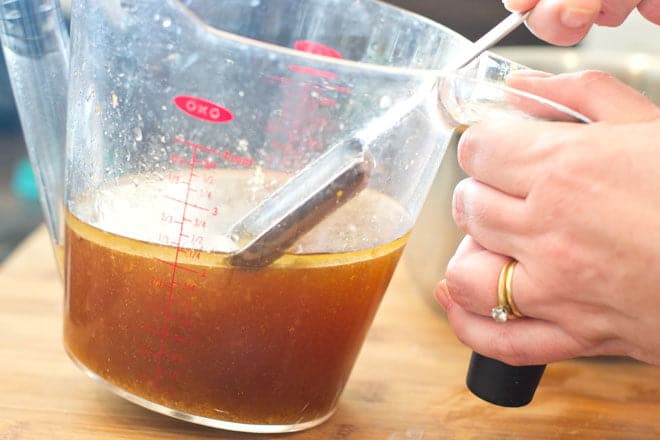
Pour the fat into a medium saucepan. Using the fat from the roast instantly gives your gravy extra roast flavor. If you don’t have that much fat on the top of your gravy separator, or if you don’t really like this idea, go with unsalted butter for your gravy recipe.
Put the butter in the medium saucepan and melt it over low heat. Then remove it from the heat and proceed with the below.
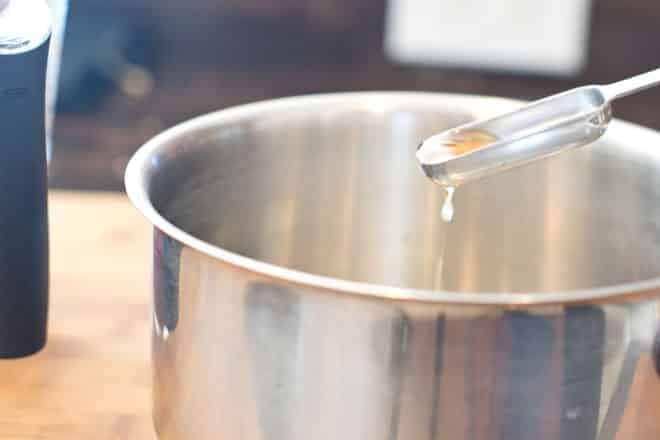
Add the same amount of flour to the saucepan as you have fat (we’re going with 4.5 tablespoons of each for 6 people).

Note: The following is NOT happening over the heat. You do this part at the counter.
Whisk the fat and flour together into a paste.
Tip: I really like using a flat whisk like this because it gets right into the edges of the saucepan. It’s one of my favorite tools in the world for all kinds of things, but especially for making gravies and sauces.
(FYI, the paste you just made is called a roux. You can use a roux like this as a base for all kinds of sauces and soups).
Step #6: Make Your Drippings Tasty
Taste First
Before you add any of the drippings to your roux, taste them. Sometimes a lot of salt or other seasoning from the outside of the roast gets washed off into your drippings.
If they’re really salty, you need to know that before you add them to the gravy. Pour a little into a bowl and slurp. They should be meaty and flavorful but not salty.
If your drippings taste great, proceed with step #7 below.
What to do if your drippings don’t taste great
If not, pour them into a large bowl, leaving the fat in the gravy separator (you don’t need this fat anymore. Discard it or save it for another use). To the liquid in the bowl, add unsalted store-bought broth or stock.
If you’re making chicken, pork, or veal gravy, use chicken broth. For beef gravy, use beef broth. You can instead use water or wine. Just make sure you’re not diluting the meaty flavor too much. If the meat flavor is very intense, water and wine will be great. If it’s less intense, you need that broth for your gravy recipe.
Keep adding broth, stirring and tasting until your liquid has a nice unsalty flavor.
Step #7: Get The Right Amount Of Liquid
Now make note of how much liquid you have. Remember, our goal this time is 3 cups of gravy so the recipe calls for 3 cups of liquid. How much do you have? If it’s more than 3 cups, you’re not going to use it all. You can add the extra to your mashed potatoes instead of milk, freeze it for later, or discard it.
If, on the other hand, you have less than 3 cups, then add to it. As noted above, you can use unsalted broth or stock, wine, or water. Only go with wine or water if the drippings are very meaty flavored. If they’re not, stick with broth or stock. Make sure it’s unsalted though. Gravy can get salty quickly as it simmers and reduces. You want control over that salt as much as possible.
Step #8: Actually Making Gravy
Whisk about one-sixth of your liquid into your butter and flour roux. You want a nice smooth paste.

Pour in a bit more and whisk it some more. You want it to be smooth after each addition. Do it a couple more times. Then you can go ahead and slowly stream in the rest of the liquid, whisking the entire time to make sure you don’t have any lumps. (If there are a few lumps, don’t worry. We’ll be straining it later).
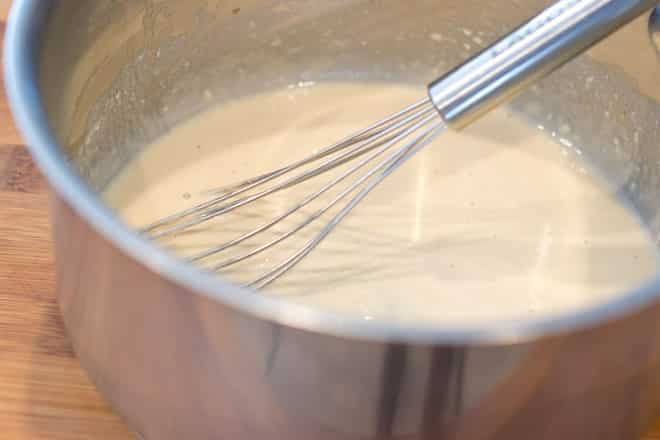
Step #9: Heat And Cook The Gravy
Once all of the liquid is in and it’s whisked and smooth, put the saucepan over medium-high heat. Stir often until it comes up to a boil.
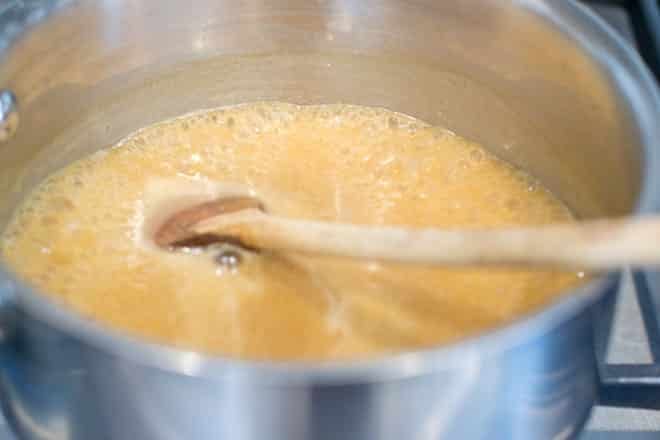
Reduce heat to low and simmer for a minute or two so the gravy thickens a little.
Step #10: Taste And Season The Gravy
Taste the gravy. What you want now is to check for seasonings. It might need a little salt and pepper. Add small amounts at a time because it can get salty quickly.
I also add poultry seasoning to chicken and pork gravies. Or whatever seasoning I put on the roast. I don’t like to add much though (about 1/4 teaspoon to 3 cups gravy). I like the gravy to taste rich and meaty. I don’t want it to cover up the flavor of the other foods on my plate.
Step #11: Strain the Gravy (optional)
OK, one last step, and it’s optional. For reasons I don’t understand, some people love lumpy gravy. Well, maybe I do get it. I also like bits and pieces of tasty stuff floating in my gravy, though not so much lumps of flour. Whatever.
Anyhow, if it’s just for us, I skip this. If it’s for company, I do it. I sit a fine mesh sieve over my gravy boat and strain the gravy in (if you’re worried about making a big mess getting it through there, strain it into a large bowl and then pour it into your gravy boat).

There you have it. That’s how to make gravy using a roux perfectly, each and every time.
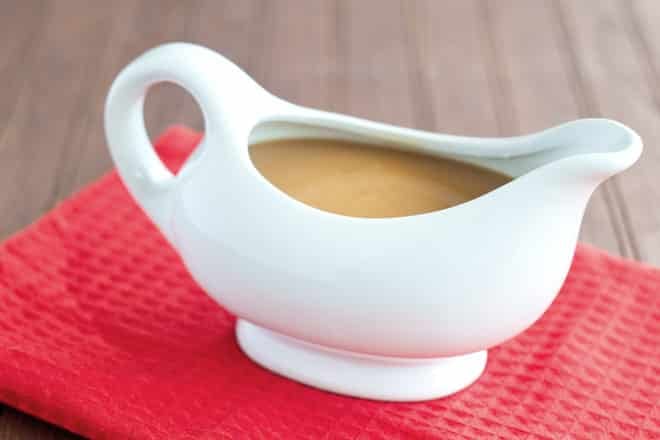
Frequently Asked Questions
Here are some questions that I’ve been asked about this gravy recipe. Have another question for me? Leave it in the comments below the recipe and I’ll try my best to get you an answer.
Many gravy recipes have you mix together the flour and fat and then cook it on the stove for a few minutes. It is said that this is to cook the flour and thus get rid of the floury taste. That is probably true, however I find that bring the eventual gravy to a simmer also cooks out the floury taste, so it’s an extra step that isn’t required. I think that cooking the roux sometimes makes it turn a nice brown color, which can make your gravy browner, which is nice. Even though that possible color can be nice though, I still don’t cook the roux and for good reason. Cooking the roux can actually make it less good as a thickener once you add the liquid. This is imprecise to me. I like to know that if I add 1.5 tablespoons of flour to 1.5 tablespoons of fat, and then add 1 cup of liquid, I will get 1 cup of gravy that is of good thickness. When I cook the roux first, it doesn’t thicken as well, which means I need to add less liquid. I find that skipping that step doesn’t adversely affect my gravy and makes it more predictable and consistent.
Yes. Follow the instructions over here. That recipe is great for when your roast doesn’t yield drippings. But it’s also great if you want to make the gravy ahead of time. Make it a bit thicker if you want to drizzle in drippings after roasting meat. You can also use that method if you’re deep-frying a turkey and don’t have any drippings at all, or if you are brining your meat and the drippings are too salty.
I have seen some older Southern gravy recipes that are finished by stirring in chopped hard-boiled eggs. While I have multiple gravy recipes on the site, I don’t have any that use eggs.
More Gravy Recipes
I love a good gravy, and all kinds of sauces too. So much so that I even have a large collection of sauce recipes over here. Head on over and browse through them. I’m also putting links to some of my favorite gravy recipes here for you:
- Best Chicken Gravy
- Onion Gravy Recipe
- Mushroom Gravy
- Homemade Bacon Gravy
- White Gravy
- Creamy Sausage Gravy
- Vegan Gravy
Podcast Episode: How To Make Gravy
Listen to me explain briefly about How To Make Delicious Gravy, with some great tips along the way, by clicking the play button below:
Listen to more Recipe of the Day episodes here.
Print
The Best Gravy Recipe
- Prep Time: 5 minutes
- Cook Time: 10 minutes
- Total Time: 15 minutes
- Yield: 6 servings 1x
- Category: Sauce
- Method: Stovetop
- Cuisine: American
DESCRIPTION
Step-by-step instructions with pictures for how to make a flour gravy that’s delicious and has the correct thickness every single time. The ratio of flour to fat to stock is given as well as the method for how to combine everything to make it taste amazing.
Ingredients
- 4.5 Tbsp. butter or fat rendered from a roast
- 4.5 Tbsp. all-purpose flour
- 3 cups drippings from roast (fat removed) or unsalted broth
- salt, pepper, and seasonings to taste
Instructions
- Melt the butter or fat in a medium saucepan over low heat. Remove from heat.
- Whisk flour into fat.
- Whisk in 1/2 cup drippings until smooth. Whisk in another half cup. Repeat until all drippings are used.
- Bring to a boil over medium-high heat. Reduce heat to low and simmer 1 minute. Taste and add salt, pepper, and seasonings.
- Strain through a fine-mesh sieve. Serve warm.
Notes
This recipe is for 6 servings. See step #4 above if you need more or fewer servings. Calculations are given there for how much fat, flour, and liquid you need per person.
This post originally appeared in November 2015 and was revised and republished in October 2022. This post contains Amazon affiliate links.
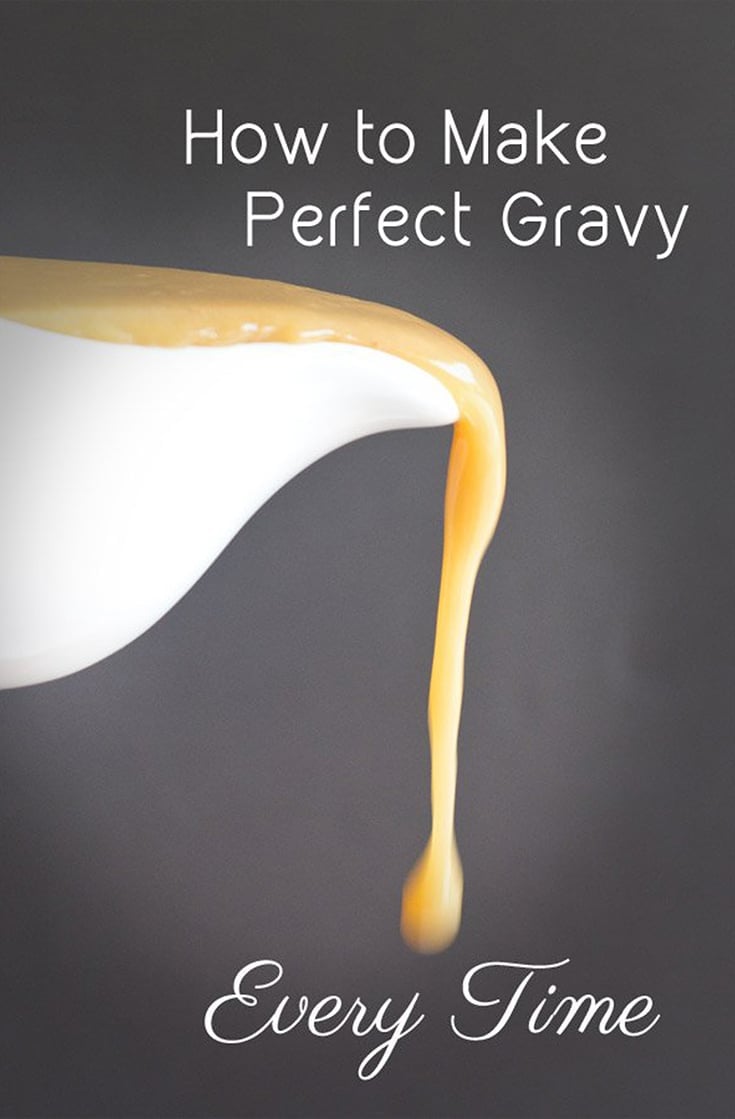

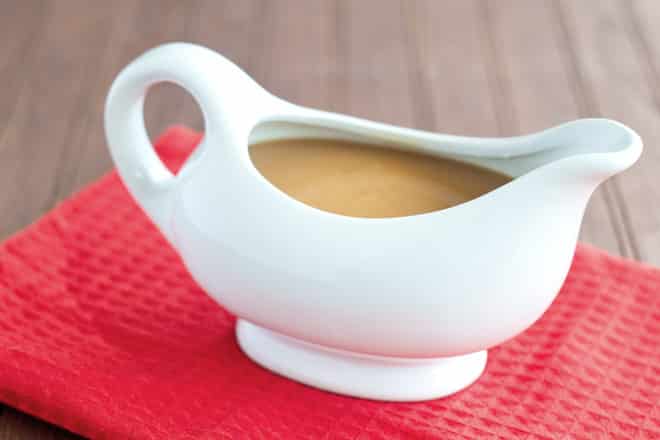
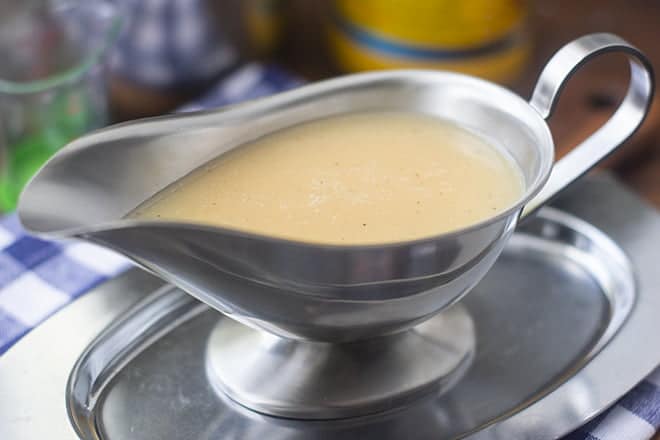
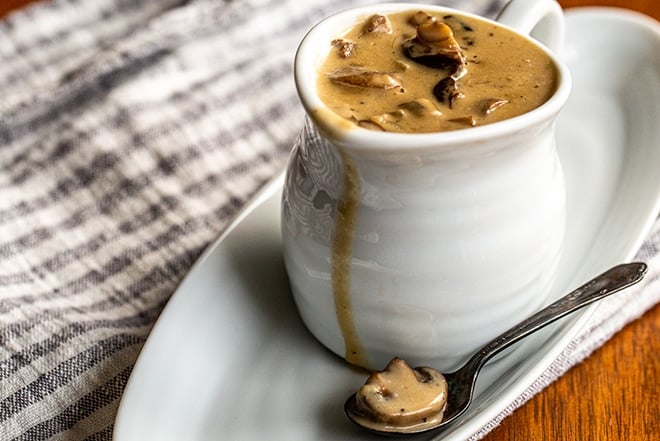
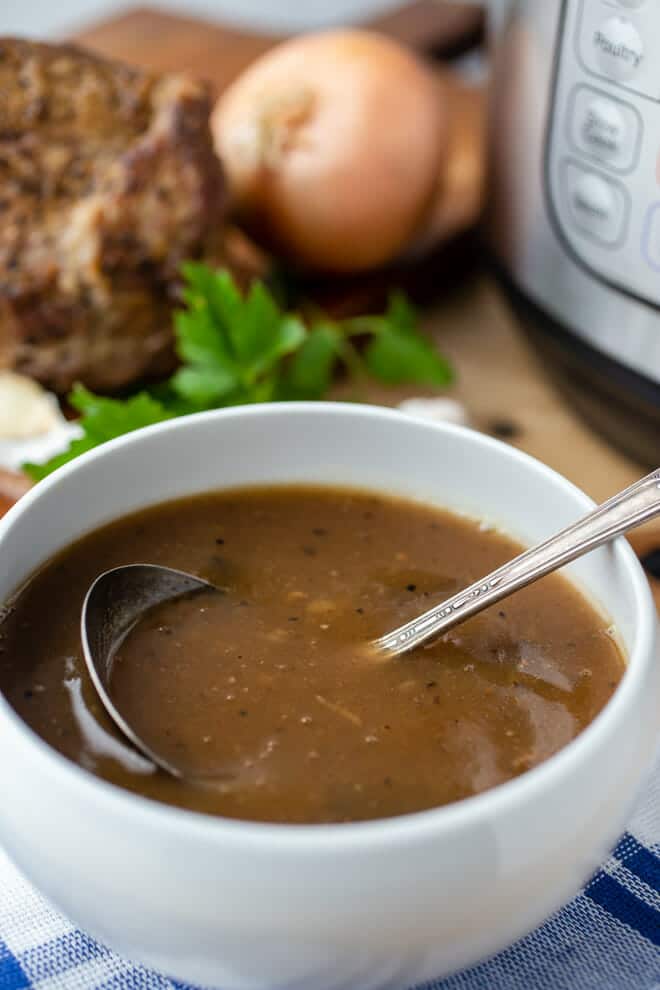



















The most delicious gravy I have ever made. I did change it up just slightly, but nothing to crazy. And I must say I honestly want to poor myself a mug full just to sip on after dinner. (Everybody will think it’s a cup of coffee) lol. Thank you for this recipe.
Haha, glad you loved it so much, Donny! Thanks for coming back to comment.
Excellent recipe. I made this with better than bouillon beef and it came out amazing. 5/5 would recommend.
Karen, that’s wonderful to hear. Thank you! And it’s great to know that you liked it with the Better Than Bouillon. Thanks for letting me know!
how can my wife get enough fat from a 18 lb. turkey to make lots of gravy she usually adds packaged ingredients to make enough for 8 people thank you for your input
Gary, getting enough drippings from a roast to make a lot of gravy can be tricky.
When it comes to turkey, I find that you generally get quite a bit. Note that you don’t need a lot of pure fat from the turkey, but instead juices called drippings. Here’s what I recommend.
First, before cooking the turkey, remove the giblets and put them in a medium saucepan. To that you can also add some of the fat and skin trimmed from the bird. I also often cut off the wing tips and put them in there too. To that you can add onion, garlic, bay leaf, celery, carrot, parsley, and peppercorns. Add water to only just cover all of that. Bring it to a boil and simmer it gently on the stove for at least an hour. Drain that and use it as extra liquid in your gravy.
When your turkey is finished roasting (I cook mine like this https://cookthestory.com/how-to-roast-turkey-perfectly/ ), remove it from the roasting pan to rest. Add unsalted chicken stock to the roasting pan and swirl it around and really scrape up anything that’s in there. Pour all of that into a gravy separator. Then, start your gravy using the fat that has risen to the top mixed with flour.
The amounts you’ll need for the number of people you want to serve are given in the post and really, https://cookthestory.com/easy-gravy-without-drippings/ is a great tutorial for everything that I’ve said above and for making gravy generally. To that, you’ll add the drippings form the bottom of the gravy separator (not the fat). Slowly whisk those in. Then, if you need more liquid for your flour-fat-liquid ratio, then you’ll use the water that you simmered with the other ingredients.
A quick extra note. Generally speaking, the guideline is to buy a turkey that is the number of pounds that you have people to feed. In this case, you’d only need an 8 pound turkey. That’s very small for a turkey, but what I really mean is that you probably don’t need an 18 pound one (12-15 pounds will do) unless you want lots of leftovers, which I completely understand. And if you follow the instructions above and in the gravy recipe, you’ll have enough gravy for 8 people for sure.
I never understood the importance of following seasoning instructions, because I don’t usually make gravy from the drippings, but I did this time, and it was way too salty- my fault. I’ll be sure to keep this in mind in the future. Otherwise, the meat came easily off the bone, tender and flavorful.
Good, detailed recipe. I am on a Whole30 and cannot have flour, so I used arrowroot powder instead. Turned out delicious and my family loved the gravy and perfect pork roast. The meal got raves last night!
Thank you for sharing your adjustment with us!
Don’t bother straining the gravy. Use a stick blender and give it a whir and sm)ooth out the lumps insteadthat way and with less possibility of mess of gravy spilling/dripping over the sides of your gravy boat.
Also, don’t use gravy boats, they loose heat so quickly. I use a plain white simple cordon blue style pitcher and 1) takes up less table space than a gravy boat, 2) retains heat better, 3) less drips compared to a gravy boat (I speak from experience on the boat vs pitcher).
Thank you for sharing your thoughts with us, Elizabeth!
OHHHH Yessss… It is just like my Mother and Grandmother made.
You explain it perfectly. You are an excellent cook and an Excellent teacher.
Thank You.
Thank you so much, Sylvia! That’s high praise and I’m so glad you’ll be able to continue making gravy like your family made.
EXCELLENT Pork Roast. Smells amazing. Just need 2 know how much is a serving per cup? oz.?Any kind of serving advice. I count Carbs. Thx! Protien & Fats r great 4 diet. But gravy serving size is helpful. Waiting while pork sits.
Ok so I googled this exact process, not necessarily for gravy but to make red chile from powder. It’s basically the same process and I never seem to make enough.
So an additional question would be, do i add the same amount of red chile powder as i do flour?
To make red chili sauce from powder, you would use twice the amount of chili powder as flour.
Using cold liquid means I never get lumps. Obviously if I’m just using drippings, that would take forever, but since I almost always add broth, I add it cold. Or if I’m using a bouillon such as Better Than Bouillon, I just add the water that’s cool and add the bouillon in after I’ve stirred the cool water into the roux.
Thanks for sharing with us, Stephanie!
I’ve been making gravy for thirty years. I learned from my grandma and it has always been like Russian roulette. I’ve gotten good at doctoring the failed efforts but it stressed me out each time. The instruction you gave that never even crossed my mind…taste the drippings, taste the roux, taste the liquid? I do that with ALL my other cooking (and I taught that to my boys when they were learning to cook) but the gravy mystified me so much that I never even considered tasting the components! I made a pork roast yesterday from your recipe and it’s great. I made the gravy today and it’s great. I can’t wait for dinner. Thank you.
For those who don’t have a gravy separator, I just put the pan drippings in a bowl and let it set in the freezer for 10-15 minutes. The fat hardens on top of the liquid and I can easily lift off the fat.
Thanks for sharing with us, Kimberly! Hope this makes future gravies much easier for you!
I made the Pork Roast and gravy YAY!! IT IS PERFECT!! Both of them! Thanks so much!!
You’re welcome, Tristan. Glad you loved it so much!
Can I use cornstarch in place of four? How much do I use? Have nephrew who does gluten free diet.
The method is different for a cornstarch gravy than for a flour gravy, Michelle. For the above flour gravy, you whisk the flour into the melted fat and then add liquid. For a cornstarch gravy, you want to already have a flavorful liquid base. Then in a separate bowl, you whisk together some cornstarch and water. Then you add that to the flavorful liquid, and you bring it up to a simmer. I don’t think that the flour and cornstarch amounts are equivalent, but I’m working on this now to find out.
What would you think of using vegetable broth with a pork roast to make the gravy?
If you want to make gravy using broth instead of drippings, we’ve got instructions here. Use any type of broth you’d like!
What do I do if I do not have a separator measuring cup?
If you don’t have a separator measuring cup, you can pour the juices into a regular measuring cup, let the fat rise to the top, then pour off the top layer, trying to not pour off the juices from underneath.